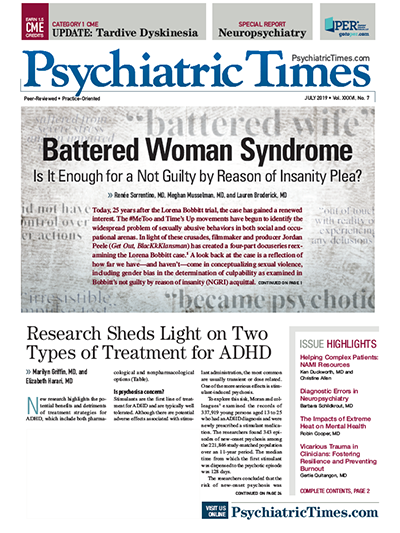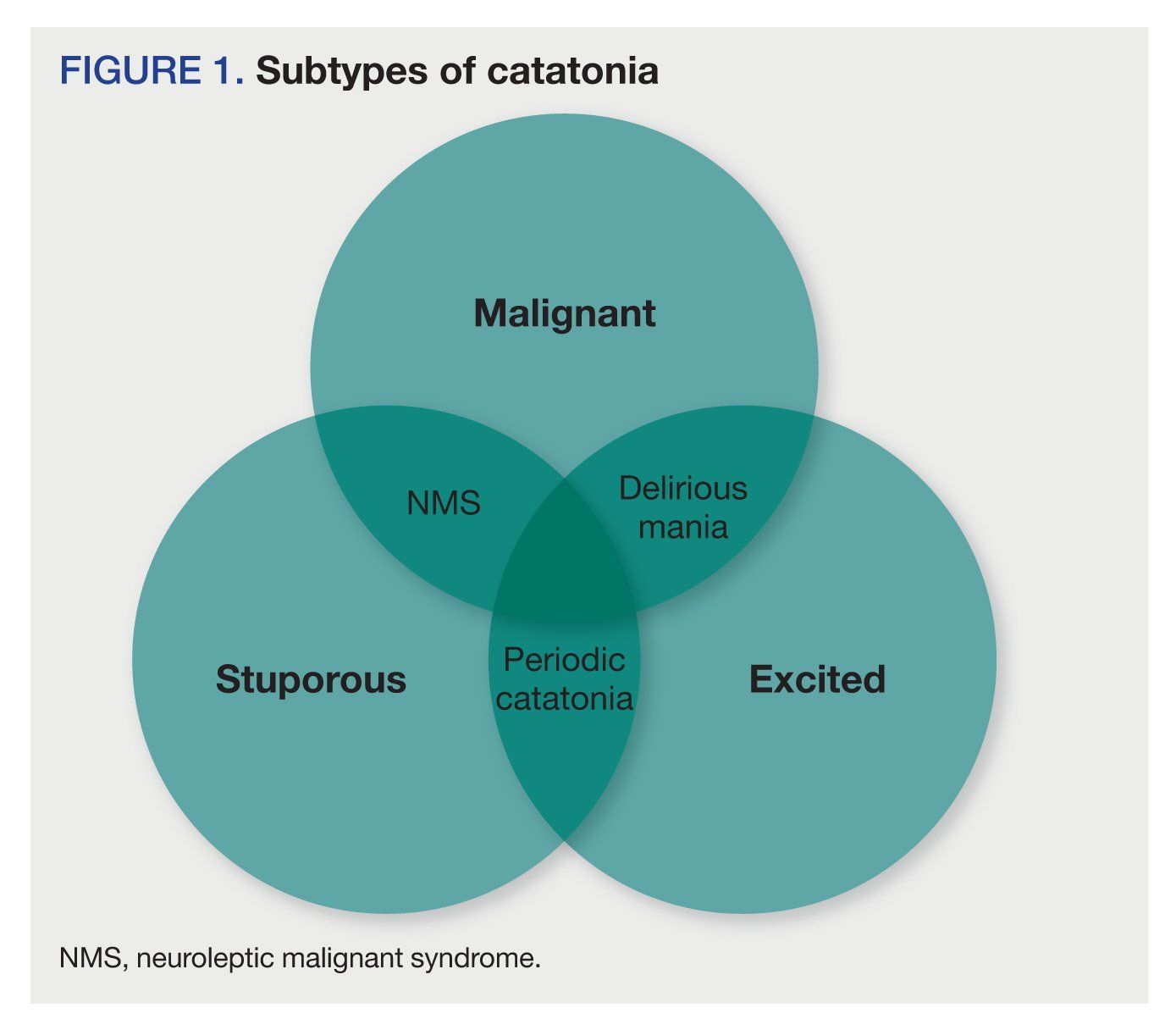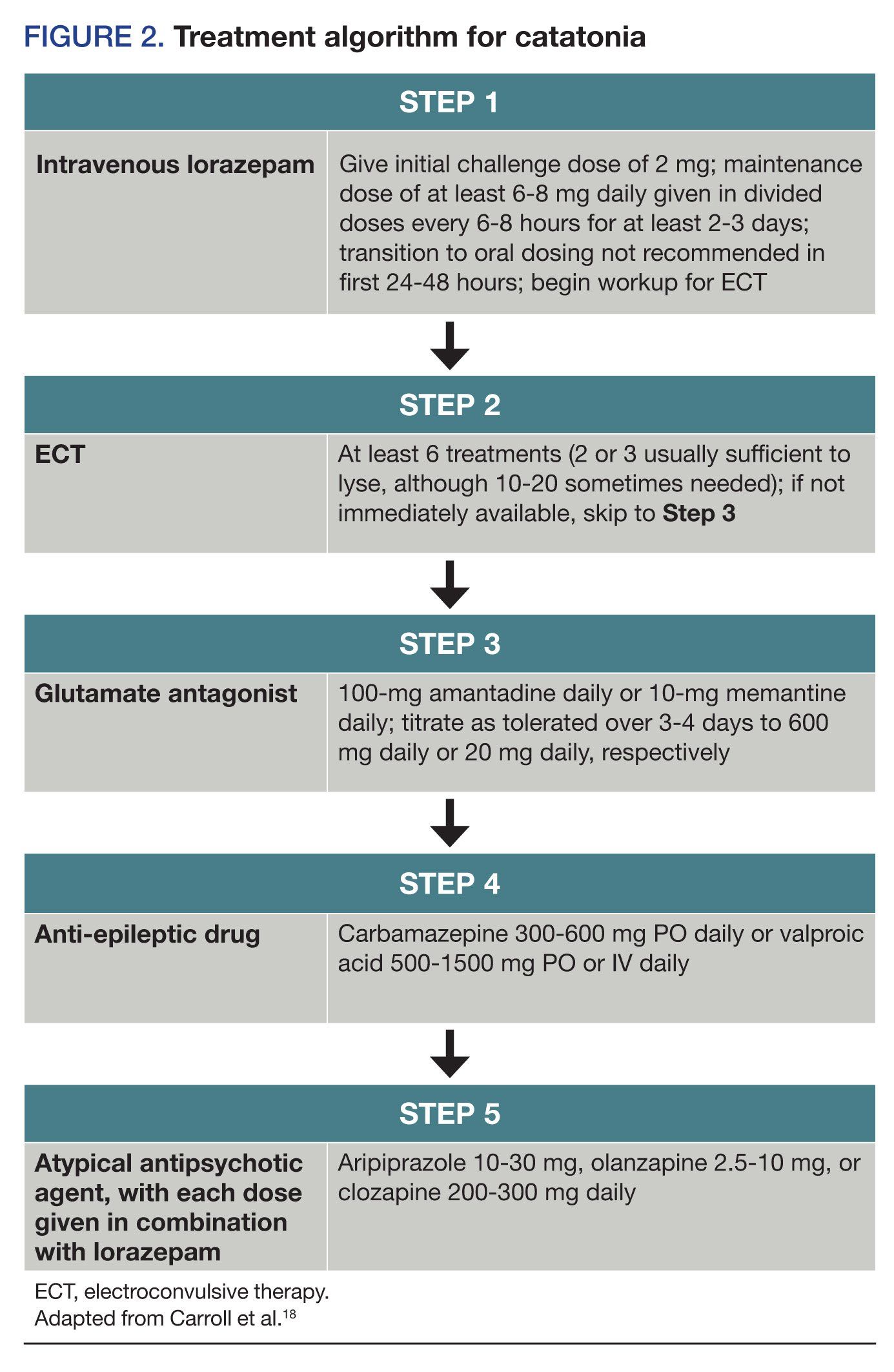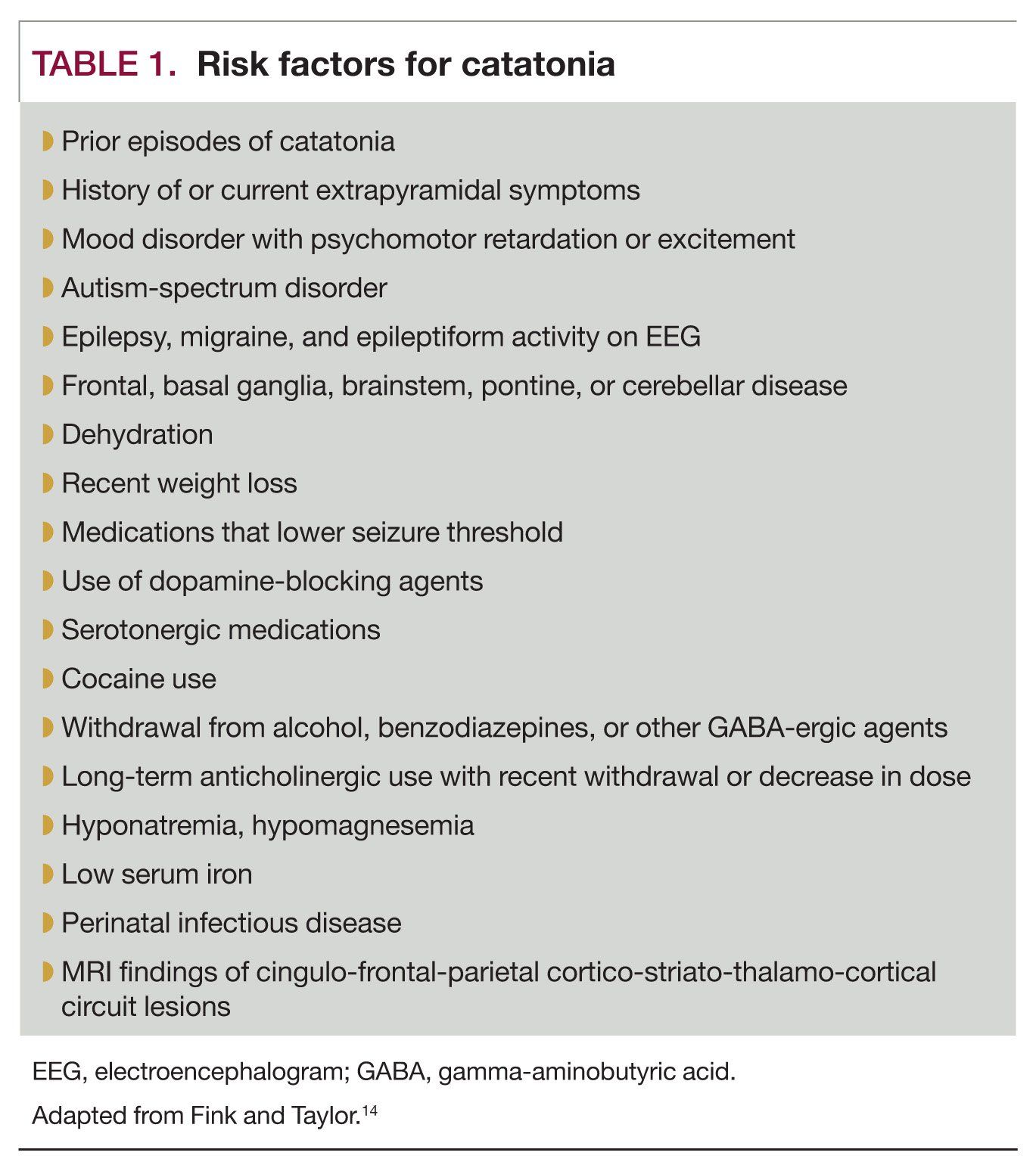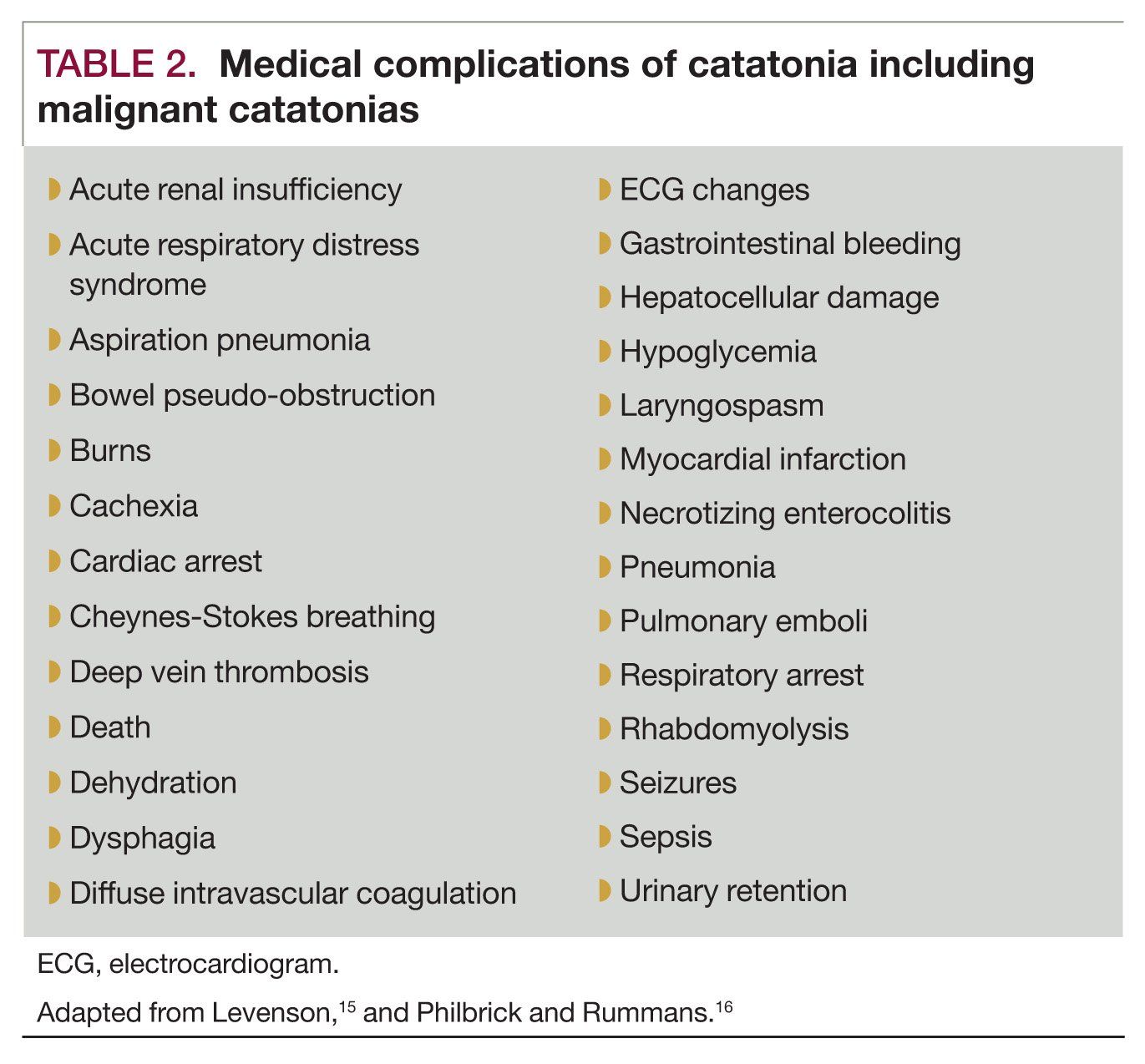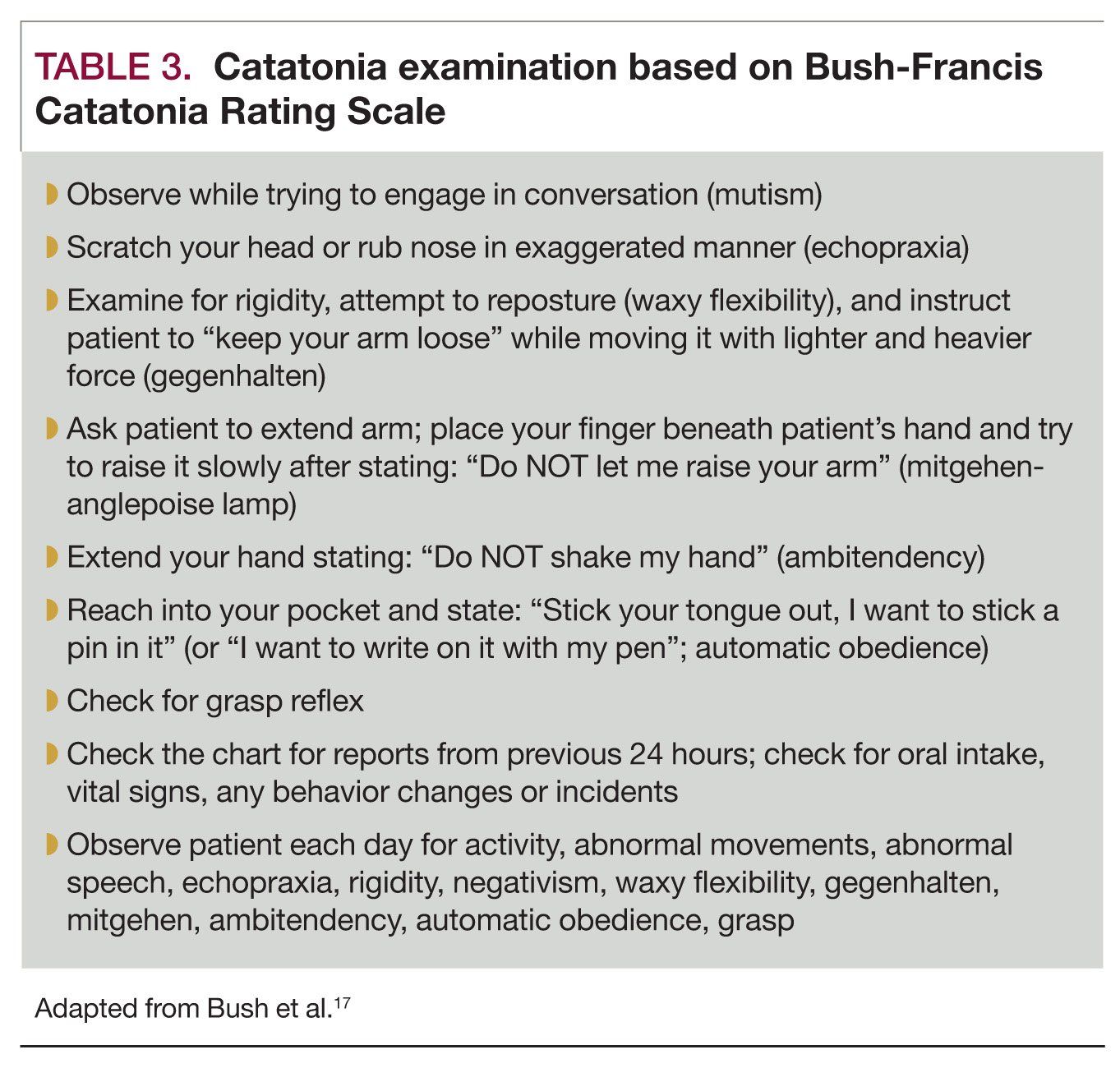Neuropsychiatry of Catatonia: Clinical Implications
As a neuropsychiatric and general medical syndrome, catatonia represents an important diagnostic and treatment challenge for all clinicians given its morbidity and mortality.
Catatonia is a neuropsychiatric syndrome in which the cluster of psychomotor signs and symptoms results in aberrations of movement and behavior. DSM-IV included new criteria for mood disorders with catatonic features, and for catatonic disorder secondary to a general medical condition. In DSM-5, catatonia is recognized as due to a medical or psychiatric condition, or unspecified, as, for example, in recurrent idiopathic catatonia. Mood disorders such as MDD and bipolar disorder are now recognized as more commonly associated with catatonia.
The diagnosis of catatonia relies on the recognition of its sometimes unusual symptoms. Three subtypes of catatonia are conceptualized in Figure 1: stuporous, excited, and malignant. Catatonic withdrawal or stuporous catatonia, includes motoric immobility, staring, mutism, rigidity, withdrawal and refusal to eat, along with more bizarre features such as posturing, grimacing, negativism, waxy flexibility, echophenomena, stereotypy, verbigeration, and automatic obedience. Excited catatonia is characterized by purposeless and excessive motor activity that includes disorganized pressured speech, flight of ideas, verbigeration, disorientation and/or confusion, and confabulation.
Catatonic signs of malignant subtype are accompanied by fever and dysautonomia. Malignant catatonia is associated with increased morbidity and mortality. A specific example of malignant catatonia is neuroleptic malignant syndrome, induced by dopamine-blocking agents or withdrawal of a dopamine or gamma-aminobutyric acidA (GABAA) agonist. Another variant, known as manic delirium or delirious mania, exists with features of both excited and malignant catatonia. Periodic catatonia can present with alternating stuporous and excited forms.
The prevalence of catatonia among psychiatric patients ranges from 7.6% to 38%.1 (See Table 1 for risk factors for catatonia.)
Pathophysiology
Catatonia has attracted neuroscientists interested in brain mediation of motivation and movement, leading to attention on neurotransmitters and circuits. Several models for the neuropathophysiology of catatonia focus on neurotransmitters. In 1985, it was hypothesized that pharmacotherapies for catatonia act on dopamine- GABA connections in the mesostriatal and mesocorticolimbic systems and in the hypothalamus.2 A restitutive dopamine system seeks rebalance through GABAA–mediated up- and down-regulation of dopamine.
When the restitutive system is dysfunctional, a vulnerability to catatonia emerges from dopamine antagonists. Carroll3 has described a “universal field theory” encompassing diverse neurotransmitter changes for catatonia. Their model postulates a reduced GABA activity in the frontal cortex, increased N-methyl-D-aspartate glutamatergic activity in the posterior parietal cortex, and a dampening of dopaminergic action in the basal ganglia.
Approaching catatonia from a circuits perspective, C. Miller Fisher4 proposed that catatonic depression emerged from connection disturbances in the same mesoencephalofrontal system (brainstem to basal ganglia to limbic system and cerebral cortex) that also leads to akinetic mutism. Northoff5 used neuroimaging in patients recovering from catatonia to uncover trait features through provocative testing of response to fearful faces and situations. He described a region of interest in the orbitofrontal cortex that overreacts in these provocative situations, which suggests dysfunctional responsiveness.
Other functional imaging studies have shown altered activity in orbitofrontal, prefrontal, parietal, and motor cortical regions.6 Recently, T1-weighted MRI imaging in catatonia secondary to schizophrenia spectrum disorders showed reduced cortical thickness in frontoparietal regions as well as hypergyrification in the anterior cingulate cortex and medial orbitofrontal cortex compared with controls.7 The basal-ganglia-thalamo-cortical loop system has been implicated in the pathophysiology of catatonia, with interruption at various nodes leading to specific symptoms of catatonia.8 For example, disruption to the anterior cingulate cortex circuit may contribute to akinesia and mutism; to the lateral orbitofrontal circuit, echophenomena; and to the supplementary motor area circuit, increased tone. Integration of these hypotheses comes closest to offering a putative pathophysiological understanding of the mystery of catatonia.
Differential diagnosis
Catatonia as a syndrome may arise from multiple etiologies and can lead to medical complications that result in significant morbidity and mortality, making rapid diagnosis and treatment a priority. Medical complications abound, and the mortality rate for malignant catatonia despite better recognition and treatment is still 9% to 10%.9 For a list of potential medical complications, see Table 2.
Catatonia has several mimics, which must be ruled out before making a diagnosis. Locked-in syndrome, linked to pontine lesions, can be distinguished from catatonia because patients will generally attempt to communicate with their eyes. Patients in a persistent vegetative state may also appear to be catatonic. Stiff person syndrome is an autoimmune disorder that presents during severe stress with intense lower extremity spasmodic stiffness that may appear like catatonic posturing, but these patients speak and complain about their pain.
Some patients suspected of being in a catatonic state may have an extrapyramidal parkinsonism. These can have a distinctive tremor but are not negativistic and lack bizarre catatonic psychomotor symptoms. Nonconvulsive status epilepticus can also produce a catatonic-like state; electroencephalography is essential for accurate diagnosis and prompt management may minimize cognitive damage.
Several additional syndromes show clinical overlap with catatonia. Like Fisher,4,10 we believe akinetic mutism, an extreme form of the abulic syndrome caused by neurological injury, to be a neurologic version of catatonia. Hypoactive delirium may overlap or coexist with catatonia. It is extremely important to confirm a delirious patient is not also suffering from a catatonic episode, because neuroleptics can worsen simple catatonia, resulting in malignant catatonia. Decreased eyeblink and resistance to eye and mouth opening may hint at a catatonia nested in delirium.
To assess catatonia, a few steps can be routinely followed (Table 3). Once the diagnosis of catatonia is made, a definable etiology must be sought. In addition to mood disorders and schizophrenia-spectrum disorders, catatonia can be seen in up to 20% of patients with autism-spectrum disorders. Case reports have described catatonia secondary to obsessive compulsive disorder, PTSD, and personality disorders.
Up to 50% of cases of catatonia may be due to a host of neuromedical syndromes. These include paraneoplastic and limbic encephalitidies (especially anti-NMDA receptor antibody encephalitis), ictal and post-ictal states, posterior reversible encephalopathy syndrome, and lupus. Substances associated with catatonia include dopamine-blocking agents, tacrolimus, disulfiram, and phencyclidine, among others. Finally, catatonia can occur as an isolated clinical syndrome without an obvious underlying cause; this phenomenon is known as recurrent idiopathic catatonia.
Management and treatment
With severe threat, challenges to brain function can emerge via circuit disconnection or modulatory dysfunction and result in catatonia. This view may underlie the effectiveness of benzodiazepine GABAA agonism, of NMDA-R antagonism, and of electroconvulsive therapy (ECT). These treatments show effects on GABA, dopamine, acetylcholine, and glutamate within cortico-striato-thalamo-cortical loops. (For an outline of a proposed catatonia treatment algorithm, please see Figure 2.)
All treatments for catatonia are off-label uses, as there is no FDA-approved drug indicated for catatonia. In 1983, lorazepam was described as a successful treatment for catatonia and later became the first-line treatment for the catatonic syndrome.11,12 A lorazepam challenge (using 2-mg intravenous [IV] lorazepam) can be a helpful diagnostic test. Although a negative response does not rule out catatonia, many patients will show improvement with a single dose. Following the challenge, a standing dose of 2 mg every 4 to 6 hours is typical; some patients may require titration to as much as 30 mg daily, especially in cases with malignant features.
Doses should be held only for respiratory depression due to oversedation and not for sedation alone, as the regularity of dosing is important for full lysis. IV lorazepam is preferred over other routes or benzodiazepine types because of its quick onset, preference for the GABA-A receptor, and long duration of effect.
Approximately two-thirds of patients will respond to treatment with benzodiazepines, although those with catatonic schizophrenia show reduced responsiveness. Catatonia sometimes re-emerges during transition from IV lorazepam to oral dosing. This may require reinstitution of IV lorazepam and an eventual higher oral dosing. There is no established guideline for how long benzodiazepine responders will require maintenance. We have had patients on benzodiazepines for weeks and even months, necessitating careful eventual taper. If decreased tolerance to benzodiazepines emerges (via increasing sedation), it is safe to gradually taper the benzodiazepine. After discontinuation, lorazepam may again be needed in cases of catatonic rebound.
If catatonia persists for more than 2 to 3 days or if malignant features are present, ECT remains the definitive treatment. ECT works synergistically with benzodiazepines and demonstrates response rates of up to 80%.13 Bitemporal placement is recommended, at a frequency of 3 times per week for at least 6 sessions. ECT may work by increasing cerebral blood flow to the orbitofrontal and parietal cortices, increasing GABA activity and GABA receptor expression, and by increasing dopamine release and modulation of dopamine receptors.
When benzodiazepines are ineffective or contraindicated and ECT is unavailable or refused, second-line treatments include glutamatergic agents, such as memantine (5-10 mg twice daily) or amantadine (400-600 mg daily in divided doses). These agents appear to be safe, well-tolerated, and effective in case reports, as monotherapy or in combination with a benzodiazepine. Other options include valproate or carbamazepine, which may be particularly useful if the catatonia is related to underlying mania. Valproic acid has demonstrated some effectiveness in excited catatonia.
A final option to consider is an atypical antipsychotic. These agents are the last step in the algorithm because of their potential to worsen catatonia or cause conversion to a malignant catatonia. Antipsychotics should be given in combination with a benzodiazepine, and low-potency atypical agents are preferred. Among antipsychotic agents, aripiprazole may be the safest choice given its partial-agonist activity. If the catatonia occurs in the setting of clozapine cessation, re-initiation of clozapine should be a first-line strategy. High-potency typical antipsychotics should generally be avoided in catatonic patients.
Supportive management is essential in cases of catatonia. In addition to treatment of the catatonic symptoms, full resolution often requires treatment of the underlying disorder. This can be challenging in cases of psychosis, which may require a careful balance of antipsychotics and benzodiazepines.
Summary
As a neuropsychiatric and general medical syndrome, catatonia represents an important diagnostic and treatment challenge for all clinicians given its morbidity and mortality. By examining the nature of cortico-striato-thalamo-cortical circuits and the effects of transmitters and modulating systems, we can better understand why such a wide array of etiologies can present with the catatonic syndrome and why the pharmacologic and electroconvulsive treatments can be very effective when provided expeditiously.
Disclosures:
Dr Beach is Assistant Professor of Psychiatry and Residency Training Director, Massachusetts General Hospital, Harvard Medical School; Dr Francis is Professor of Psychiatry, Associate Director of Residency Training, and Director of Neuromodulation Services, Penn State Medical School, Hershey Medical Center, Hershey, PA; Dr Fricchione is Professor of Psychiatry, Mind Body Medical Institute and Associate Chief of Psychiatry, Massachusettes General Hospital, Harvard Medical School, Boston, MA. Drs Fricchione and Beach have received funding through the David Judah Fund for catatonia research.
References:
1. Taylor MA, Fink M. Catatonia in psychiatric classification: a home of its own. Am J Psychiatry. 2003;160:1233-1241.
2. Fricchione GL. Neuroleptic catatonia and its relationship to psychogenic catatonia. Biol Psychiatry. 1985;20:304-313.
3. Carroll BT. The universal field hypothesis of catatonia and neuroleptic malignant syndrome. CNS Spectr. 2000;5:26-33.
4. Fisher CM. Honored guest presentation: abulia minor vs. agitated behavior. Clin Neurosurg. 1983;31:9-31.
5. Northoff G. What catatonia can tell us about “top-down modulation”: a neuropsychiatric hypothesis. Behav Brain Sci. 2002;25:555-577.
6. Northoff G. Catatonia and neuroleptic malignant syndrome: psychopathology and pathophysiology. J Neural Transm. 2002;109:1453-1467.
7. Hirjak D, Kubera KM, Northoff G, et al. Cortical contributions to distinct symptom dimensions of catatonia. Schizophr Bull. February 2019; Epub ahead of print.
8. Fricchione G, Mann SC, Caroff SN. Catatonia, lethal catatonia, and neuroleptic malignant syndrome. Psychiatric Annals. 2000;30:347-355.
9. Tuerlings JH, van Waarde JA, Verwey B. A retrospective study of 34 catatonic patients: analysis of clinical care and treatment. Gen Hosp Psychiatry. 2010;32:631-635.
10. Fisher CM. “Catatonia” secondary to disulfiram toxicity. Arch Neurol. 1989;46:798-804.
11. Fricchione GL, Cassem NH, Hooberman D, Hobson D. Intravenous lorazepam in neuroleptic-induced catatonia. J Clin Psychopharmacol. 1983;3:338-342.
12. Bush G, Fink M, Petrides G, Dowling F, Francis A. Catatonia. II. Treatment with lorazepam and electroconvulsive therapy. Acta Psychiatr Scand. 1996;93:137-143.
13. Petrides G, Divadeenam KM, Bush G, Francis A. Synergism of lorazepam and electroconvulsive therapy in the treatment of catatonia. Biol Psychiatry. 1997;42:375-381.
14. Fink M, Taylor MA. Catatonia: A Clinician’s Guide to Diagnosis and Treatment. New York, NY: Cambridge University Press; 2003.
15. Levenson JL. Medical aspects of catatonia. Prim Psychiatry. 2009;16:23-26.
16. Philbrick KL, Rummans TA. Malignant catatonia. J Neuropsychiatry Clin Neurosci. 1994;6:1-13.
17. Bush G, Fink M, Petrides G, Dowling F, Francis A. Catatonia I: rating scale and standardized examination. Acta Psychiatr Scand. 1996;93:129-136.
18. Carroll BT, Goforth HW, Thomas C, et al: Review of adjunctive glutamate antagonist therapy in the treatment of catatonic syndromes. J Neuropsychiatry Clin Neurosci. 2007;19:406-412. â
